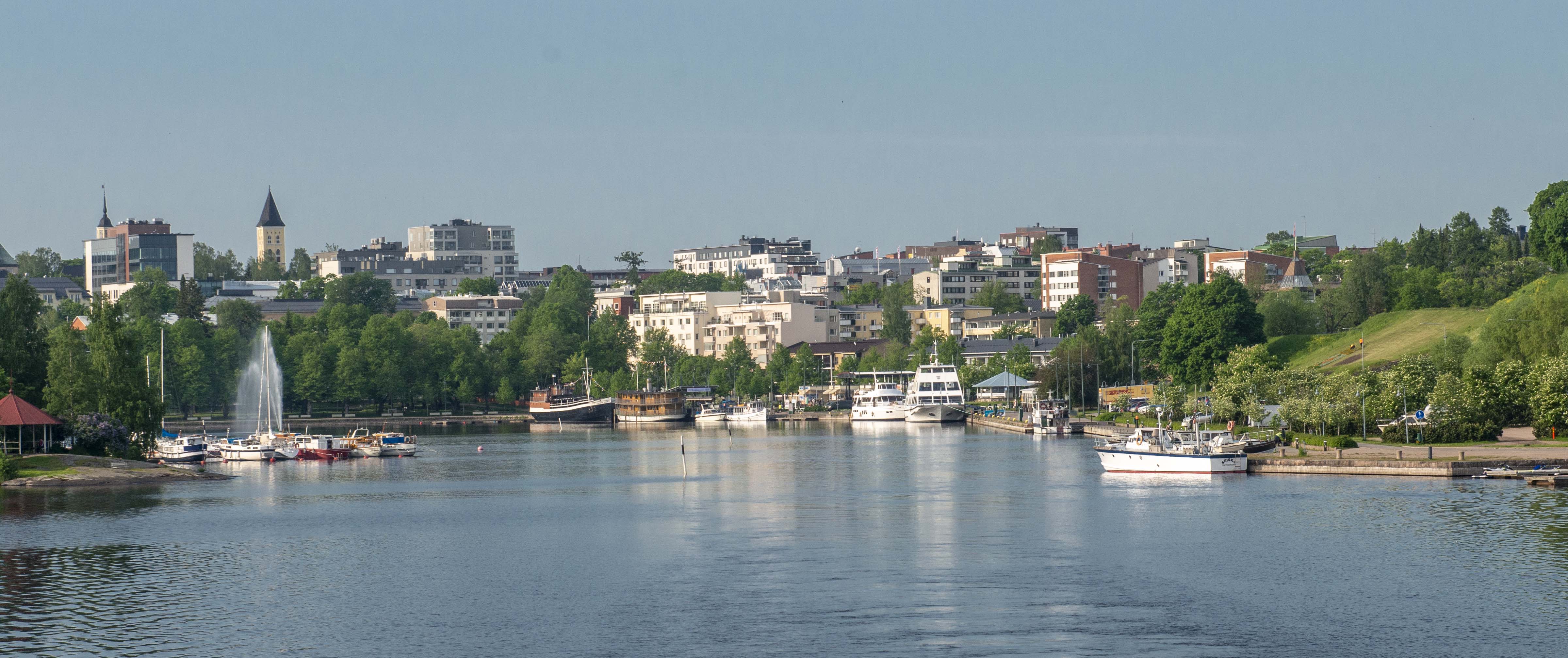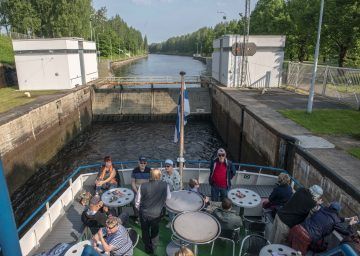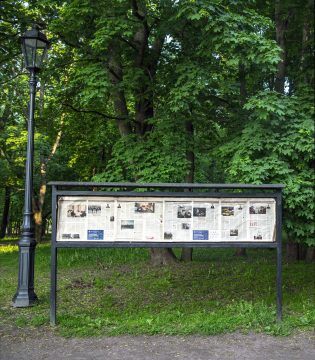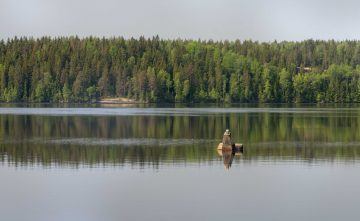by Bill Murray
A few months ago, Mikhail Saakashvili, ousted leader of the former Soviet Republic of Georgia and the Ukrainian town of Odessa, predicted that Russia would next attack either Sweden or Finland. A few days ago I visited the Finnish and Russian border towns of Lappeenranta and Выборг (Vyborg), and if war preparations in these two places are any indication, Sweden had better man the barricades.
For people of a certain age, coming to Russia from any direction sends up a certain Cold War frisson. Today we shall cross the border from Finland, which has been fought over and traded between Sweden and Russia for centuries.
 As early as 1293 a Swedish marshal built a castle in Vyborg, now Russian. The castle traded hands repeatedly between the Swedes and the then Republic of Novgorod. With the collapse of the Soviet Union and loss of fortresses in Narva, Tallinn and Riga, Vyborg Castle is the only European-style medieval castle in Russia. Its current iteration is touted as a prime tourist destination but appears to be randomly, and arbitrarily, closed for renovation.
As early as 1293 a Swedish marshal built a castle in Vyborg, now Russian. The castle traded hands repeatedly between the Swedes and the then Republic of Novgorod. With the collapse of the Soviet Union and loss of fortresses in Narva, Tallinn and Riga, Vyborg Castle is the only European-style medieval castle in Russia. Its current iteration is touted as a prime tourist destination but appears to be randomly, and arbitrarily, closed for renovation.
Viipuri, in the Finnish appellation, was capital of Finnish Karelia and a vital outlet to the sea until Vyborg was seized by the Red Army in June of 1944. John H. Vartenen, in a 1979 New York Times article:
The Finns felt that to some extent they had won the war on the ground by forcing the Russians to come to the negotiating table. On the other hand, they felt that they lost at the table because, though the Russians had never moved more than 50 miles into Finland, the Finns lost eastern Karelia, including the area’s second‐largest city, Viipuri.
While Vyborg is almost exactly the same size today as when it was taken from the Finns, for 75 years it has been Russified. If you were twelve years old on the day Viipuri fell and had a child of your own five years later, that child would now be 70. Teaching Finnish was out of the question in early Russian-occupied Vyborg, but even for those who quietly did so, use of the language is dying – except in tourism.
 Lappeenranta in Finland and Vyborg straddle the border, some thirty miles apart. They’re kin, cousins of a sort, on the border between cultures as well as countries. From the early 19th century until World War II when it fell victim to heavy Soviet bombardment, Lappeenranta went about its business as a peaceful backwater, its great leap forward coming with the inaugural service of a canal to the Gulf of Finland in 1856, when traversing it was a domestic Finnish trip.
Lappeenranta in Finland and Vyborg straddle the border, some thirty miles apart. They’re kin, cousins of a sort, on the border between cultures as well as countries. From the early 19th century until World War II when it fell victim to heavy Soviet bombardment, Lappeenranta went about its business as a peaceful backwater, its great leap forward coming with the inaugural service of a canal to the Gulf of Finland in 1856, when traversing it was a domestic Finnish trip.
Today the two countries couldn’t be on more divergent policy tracks. Lappeenranta’s new national government is proposing 3.1% of its budget for financing the introduction of methods to replace animal testing, establishing a government zoological advocate and environmental research. Russia is better known for the unfortunate fate of pesky journalists and regime opponents than for concern with the fate of lab rats.
Lappeenranta won’t deck you with its dynamism, but it prospers in a low-key way, unselfconsciously implementing a national commitment to climate friendliness. A green city, Lappeenranta set a goal in 2009 to decrease carbon dioxide emissions 30% by 2020, and beat it by six years. 85% of Lappeenranta district heating comes from forest biomass.
Its biggest employers are the city itself, a forestry products company and a 5000 student University of Technology. Like Vyborg, Lapeenranta takes pride in heritage, its “original core settlement set on a headland jutting into Lake Saimaa, the site of the present” bastion, which still shows scars of fighting with the Russians. It markets itself as a city for lakeside summer tourism, and welcomes Russian shoppers, the relatively well-to-do after products not available across the border.
Infrastructure in both countries’ borderlands facilitates extraction of timber. The forestry sector provides over 20 per cent of Finland’s export revenue, a major employer. Log-laden rail cars emerge from the forest to cross the bridges built across the marshy lowland alongside the Gulf of Finland. Trains of trees sit idle at rail sidings on both sides of the border.
Finland’s Lake Saimaa (the world’s longest lake coastline, 13,710 islands, the fourth largest natural freshwater lake in Europe), is 76 meters above sea level. While it is possible to sail west to the Gulf of Bothnia and onward to the Atlantic, so it is possible, and far faster, to sail to the Gulf of Finland (graciously named the same in Russian (Finnish Suomen Lahti, Russian Finsky Zaliv), via the Saimaa Canal.
Finland leases the canal as the quickest way to market for its wood products. The current deal runs to 2063 allowing Helsinki to import and export timber, paper and pulp. Finland pays €1.22 million annually plus a traffic-based supplement.
Attempts to connect Lake Saimaa to the sea date back five hundred years. It may be a good thing those early attempts failed. Some believe with the technology of the time, early engineers would have merely drained the lake clear to the sea.
•••••
Mirroring Lappeenranta is Russian Vyborg. An easy way to visit affords same day, one or two night visa-free travel via a five-and-a-half hour daily cruise through the locks of the Saimaa Canal aboard the M/S Carelia.
Five nationalities chug toward Russia today, according to the chatty public address lady, a vastly Finnish, mostly older crowd, with enough finger-wagging moms chasing kids to irritate everybody else. Even with the lowest fertility rate among the Nordic countries, below replacement rate, Finns manage to fill every public place with roadblocks of baby carriages.
People point their phones wherever Miss Public Address instructs them, including at the ungainly sprawl of an industrial plant called UPM Biofuels, a vast collection of dismembered and forlorn former forest.
 The first of eight canal locks fascinates every phone camera on the ship; the further seven are largely ignored. The tallest lock fills to 12.4 meters. It’s a little creepy that they are all operated by remote control. Huge machines close around you and no one is there.
The first of eight canal locks fascinates every phone camera on the ship; the further seven are largely ignored. The tallest lock fills to 12.4 meters. It’s a little creepy that they are all operated by remote control. Huge machines close around you and no one is there.
The canal is only 43 kilometers long, Lappeenranta and Vyborg just 30 miles apart. Still, the M/S Carelia will make a day of it, five and a half hours vending food, drink and an unattended singalong.
Halfway through the five hours, the lady forever on the microphone summons us inside for a stern lecture on Russia, which, it turns out, is a foreign country, with it’s own ways and customs. This earnest lady lectures from a sort of bandstand where old Juri the guitarist couldn’t cajole his singalong.
“Keep your things safe!” “Bargain!” “Turn off your phones!” Her caution here is that predisposed Russians are pretty good at scooping up credit card information from your phones and selling it on (I took an old Nikon, an actual camera, and didn’t use internet). The Russians aboard, whom we might assume know the ins and outs of cell phone use in their country, enjoy the sun outside.
As we go line by line through the entry form, minds wander the length and breadth of the cabin. Please fill it out correctly! (It reads, incidentally, “Russian Federation and Republic of Belarus” as if Belarus were an indentured servant.) For those who have ever traveled abroad, her instructions are as useful as those airline safety instructions on how to buckle a seatbelt, for those who have never been in a car.
A German man once tried to import forty fine German sausages. Ate as many as he could, surrendered the rest! Just the other day a man held up the ship four hours by not reporting back on time! He had a separate visa or something, thought he’d head on down to St. Petersburg, but the authorities held the ship until he could be found! Please be on time!
Once we get to Vyborg, with my Amerikanski passport I am pulled into a room for questions about my previous military service, my current military friends and my previous visits. The pass control gentleman carefully notes “Lake Baikal” and “Ulan Ude” along with Ekaterinburg, St. Petersburg and Moscow as places I’ve been.
In the post office I use back home, they tear off those forms you fill out when you send a package abroad, keep them in the back room for a month, then throw them away. Wonder if they do that in Russia.
Outside the door a bent-over elderly lady in a print dress waits to enter the interrogation room. “Random,” the official explains.
•••••
Выборг (this is the script on the arrivals side of a monument outside the train station. It is written as Wyborg on the other side) is lovely and cloudless on the sixth day of June. Spring flowers and those thistles kids blow on to scatter seed.
 Viipuri’s endearing, enduring attraction is two generous, breathing lungs, the Lenin and Esplanade parks, adjacent and running right through town (south of Prospeckt Lenina, and opposite Red Square and the Lenin statue) extensive green space with trees so old they must be a Finnish inheritance.
Viipuri’s endearing, enduring attraction is two generous, breathing lungs, the Lenin and Esplanade parks, adjacent and running right through town (south of Prospeckt Lenina, and opposite Red Square and the Lenin statue) extensive green space with trees so old they must be a Finnish inheritance.
With all that green space, a wee bit of initiative and imagination, the government could partner with private enterprise for endless terrace cafés under the trees, the enticing fragrance of grilling shashlik wafting all along the green space.
There is blessedly little ugly Soviet architecture. Not enough time for Khruschevian housing blocks to reach the periphery or a greater sensibility out on the border? Love to know which.
We are in a provincial, peripheral, underinvested border town. One may need to head down to Sochi to have a look at Putin’s idea of engaging with the world. Whatever it may be, it is not on display in Vyborg.
Except remember even down in Sochi those two toilets per stall? Cheap-shot Russian characteristics? Here too. Touch the shampoo disperser in the Victoria hotel, the cover falls to the tub. You must ding the big brass bell every last bloody time to summon staff from their nail files in the back room.
Clerks (though not the barkeep) grudgingly dispense minimal English, unwilling to engage. You can type at each other to no effect through the clerk’s phone translation app.
The hotel hasn’t enough money in the till to give change of twenty Rubles, which is thirty-one cents. Elsewhere you imagine a helpful clerk opening her pocketbook to make change, or dispatching staff to exit the automatic doors, pace twenty steps, enter bank next door, exchange coins, change client’s money. But in the end, a shrug. It is not possible.
Just across the square it’s a different story. In the kauppa halli (the shop hall), every vendor speaks hectoring Russian, Finnish, English, German with verve and salesmanship.
•••••
Last month’s column was filed from Vietnam, where the largest privately-owned company is Vingroup, with some 43,000 employees and interests in real estate, telecommunication, shopping malls, healthcare, education, automobile production. It has just opened Landmark 81, the 16th tallest building in the world, in Ho Chi Minh City.
Vingroup’s founder, Phạm Nhật Vượng, must surely be one of the wealthiest people in the country. But as any number of Russian oligarchs in and out of exile could testify, in a closely controlled oligarchy, prosperity comes with peril. The scheme seems to be, let a few people get rich and have them build out the leadership’s aspirations. This works out better for some than others.
Vietnam is surrounded by countries with like-minded, government-controlled economies but things are very different for Vladimir Putin. Of Russia’s 14 border countries, the systems in nine (Norway, Finland, Estonia, Latvia, Lithuania, Poland, Ukraine, Georgia, and Azerbaijan) range from government-directed to robust capitalism.
Perhaps the infection of capitalism from the periphery is more of a concern in the Kremlin than in Hanoi. Which may mean holding back on investment in places like Vyborg, a city that appears reticent to opening to the world. Unengaged by design.
The dissolution of the Soviet Union that Putin called the “catastrophe of the century” began at its edges, first with Armenia and Azerbaijan in armed conflict, Ukraine (literally in Russian “frontier”) pulling away, and then violence and death in the loss of the Baltic states.
Maybe the quote attributed to Hemingway about how bankruptcy happens slowly then all at once, applies to regime change too (see Omar al-Bashir in Sudan, Park Geun-hye in South Korea, Luiz Inácio Lula da Silva in Brazil and others). The regimes of Ceauescu and Hoxha, to name two in Russia’s neighborhood, were stable until they weren’t, weren’t they?
But perhaps not to over-analyze. Freezing Vyborg out of central government investment may be nothing more than benign neglect in a country for which neglect, benign and otherwise, is a honed science.
•••••
These northern woods are the same and they look and smell and feel (and the mosquitoes bite) the same from here to Kamchatka. One difference: when you pass the canal lock that reads пялаи/palli westbound, what falls away is the unstated but implied threat of governmental thuggery.
 A funny, listing concrete marker in the water is the border between Russia and Finland, to which our attention is called. Now, coming back, in theory you may turn on your phone, take this picture and Russian hackers won’t institutionally steal your credit card information. These are old tourists on a lark. They are not for burner phones. Could be rife pickings.
A funny, listing concrete marker in the water is the border between Russia and Finland, to which our attention is called. Now, coming back, in theory you may turn on your phone, take this picture and Russian hackers won’t institutionally steal your credit card information. These are old tourists on a lark. They are not for burner phones. Could be rife pickings.
After September 11th, 2001 a proud British father shared with me how his son’s job with the RAF was to fly over Afghanistan scooping up details on every active SIM card in the country. Once they had that information, any phone used in the U.K. with any of those SIM cards was automatically geo-synced and swooped upon. A rather different use of government stealth than stealing credit card numbers.
Presidents Sauli Niinisto of Finand and Vladimir Putin of Russia celebrating 100 years of Finnish independence (from Russia) on Lake Saimaa, August, 2017.
- Photos by the author.

